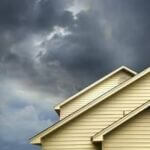
February 11, 2025
lmorgan_lauren@tbba.net
A new report estimates that the U.S. housing market may face a $1.5 trillion reduction in property values over the next 30 years due to climate change, but resiliency efforts may mitigate the factors arising from severe storms and wildfires.
The report from First Street Foundation, a climate risk financial modeling nonprofit, concludes that rising property insurance rates will exceed mortgage payments and alter consumer demand. Specifically, the report cites that insurance companies' response to climate risk have “materially changed the calculus behind home ownership and the desirability of communities” around the nation.
Climate occurrences such as Hurricanes Milton and Helene will prompt insurance providers to increase premiums or deny coverage of areas continually impacted by catastrophic areas, potentially changing migration patterns and pulling more people to pockets of the North and Midwest.
“Regional desirability is being reshaped by chronic changes in climate across the country: coastal areas are increasingly threatened by sea level rise, while inland regions face intensifying heat waves, droughts, and floods,” the report stated. “At the same time, the increased frequency and intensity of natural disasters has triggered unprecedented levels of property damage, prompting insurance providers to increase premiums or withdraw coverage from high-risk areas altogether.”
The report specifically identified Miami, Jacksonville, Tampa, New Orleans, and Sacramento as the five top metro areas likely to see a rise in property insurance costs.
Yet, that doesn’t necessarily mean these areas and other parts of the Sun Belt will suffer a decline in growth or demand.
“They also have a lot of amenities, and right now, those amenities are outweighing the dis-amenities of climate risk,” First Street Foundation’s Jeremy Porter told NPR’s Marketplace. “And people are still moving to those areas.”
A 2024 University of Michigan Department of Economics report echoes Porter’s assertion that areas with amenities will continue to grow, specifically noting that those moving to Florida think more about warmth, beaches, job opportunities and no state income tax more than the latest hurricanes. Yet the report also surmises that it’s the wealthy that will continue to find the Sunshine State attractive, while the less affluent will likely move away from the state in a quest for more affordable housing accommodations.
“As tropical storms and climate change continue to become more detrimental to coastal homes,” noted the University of Michigan report, “it appears that the housing market in Florida will rely upon wealthy families, who can both afford to pay for flood insurance and to rebuild their homes when disastrous storms wreak havoc upon them.”
Florida Moving Inland Trend
However, the report didn’t note the migration may involve homeowners moving to inland parts of Florida and building more resilient homes and investing in other resiliency efforts.
Some experts think government should spur economic development in areas more likely to attract migration. Others note the long-term benefits of more resilient homes outweigh the short-term pricing pains. Several local builders, have already increased their emphasis on resiliency efforts.
“Yes, it may cost a few thousand dollars more — and I’m not underselling what that means for many families — but that can lead to longer term savings over time for them,” said Michael Newman with the Insurance Institute for Business and Home Safety.
Kimiko Barrett, a wildfire research and policy analyst at Headwaters Economics, is advocating for the establishment of a federal agency that could look at community wildfire risk reduction, providing dedicated investment before a wildfire becomes a disaster. But in a recent interview with Marketplace, Barrett said the nation must look beyond wildfire risk and consider all the impacts of climate change.
“We as a society, at all levels, must be prepared for living with this increasing future of climate hazard and disaster,” Barrett told Marketplace. “So now is the time to deliberately and thoughtfully think through what kind of future [that is] going to be and how do we integrate these building practices into new development and retrofits before a disaster takes place?”
